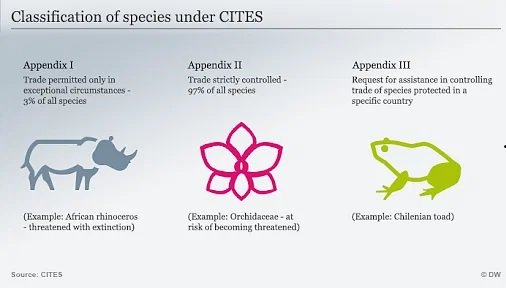India has been removed from Review of Significant Tradefor Red Sanders: Basics Explained

Under the Convention on International Trade in Endangered Species (CITES), India has been removed from the Review of Significant Trade (RST) for Red Sanders, which can be a major boost to farmers who grow Red Sanders for export, the Union Environment Ministry has said.
India has been under the RST process for Red Sanders since 2004. The CITES RST process enables disciplinary action in the form of trade suspensions directed at countries that do not meet their obligations. India has been a party to the CITES since 1976.
LEARNING FROM HOME/ WITHOUT CLASSES/ BASICS
Global biodiversity is facing a crisis with many species on a rapid path to extinction.
CITES is an international agreement between governments. Its aim is to ensure that international trade in specimens of wild animals and plants does not threaten the survival of the species. Located in Geneva, Switzerland, the CITES is administered by the United Nations under its UNEP (United Nations Environment Programme) Wing.
It regulates the cross-border movement of species (animal and plant) listed on the
Appendices to the Convention for both trade and non-commercial (e.g., scientific) purposes. It applies to live animals, carcasses and any parts or derivatives). Any such movement must be authorised by CITES import and export permits issued by the CITES Management Authority,
Although CITES is legally binding on the Parties – in other words they have to implement the Convention – it does not take the place of national laws. Rather it provides a framework to be respected by each Party, which has to adopt its own domestic legislation to ensure that CITES is implemented at the national level.

Appendix I includes species threatened with extinction, for which international trade is only permitted in exceptional circumstances. Appendix II includes species that may become threatened in the future if international trade is not regulated, and Appendix III contains species that are protected in a country, and is a way to seek other Parties’ assistance for controlling the trade in the listed species.
India is one of the 17 megadiverse countries of the world. With only 2.4% of the world‟s land surface, it harbours about 8% of the known global biodiversity.
The National Board for Wildlife (NBWL), which is chaired by the Prime Minister of India provides for policy framework for wildlife conservation in the country. India has enacted various legislations for the management of the wildlife and biodiversity resources of the country.
Some of these important legislations are the Indian Forest Act, of 1927, the Wild Life (Protection) Act of 1972, the Biological Diversity Act of 2002 and Biological Diversity Rules of 2004, the Fisheries Act of 1897, The Patents Act of 1970, the Protection of Plant Varieties and Farmers’ Rights (PPVFR) Act of 2001, the Prevention of Cruelty to Animals Act of 1960, the Foreign Trade (Development and Regulation) Act of 1992, the Environment (Protection) Act of 1986, the Forest (Conservation) Act of 1980, the Scheduled Tribes and Other Traditional Forest Dwellers (Recognition of Forest Rights) Act of 2006, the Destructive Insects and Pests Act of 1914, the Ozone Depleting Substances (Regulation and Control) Rules of 2000.






0 Comments